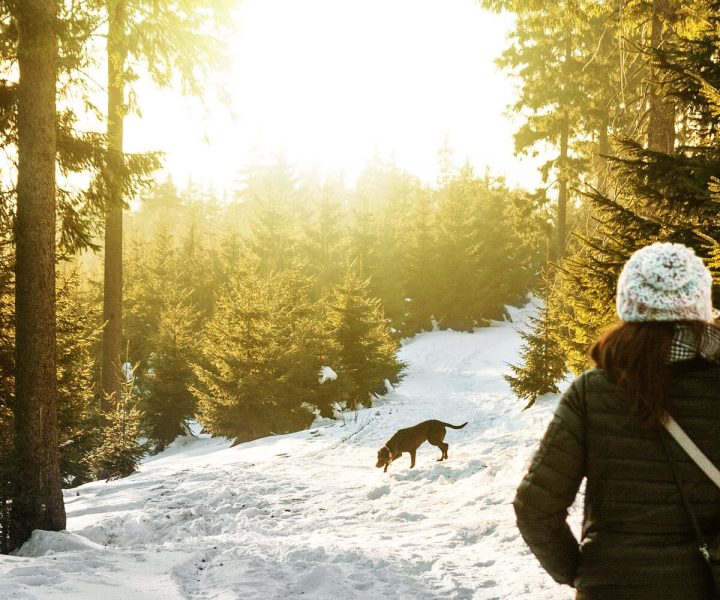
This upcoming winter, don’t leave your dog at home while you venture out on an outdoor adventure. While you may be concerned that the weather will be too much for your furry friend to handle, winter can actually be a great time to hike with your dog.
You just need to keep a few precautions in mind and plan your trip well to ensure that your pup stays safe while enjoying the great outdoors.f
Getting Started
The first thing you need to do when planning a winter hike and you want to bring your dog is to ask yourself if your dog is physically fit. Trail conditions can drastically change during winter, as they may be covered in snow or very slippery. Varying conditions can mean that you will be hiking more slowly and therefore for longer, so you need to make sure your dog is fit enough to handle the hike.
Another thing to keep in mind is your dog’s age. Older dogs and puppies can’t go on winter hikes, unfortunately, as wading through snow can injure them, and the cold will affect them faster.
Gear up your dog
If you’ve decided that your dog is fit enough to come with you on your winter hike, make sure you bring along some essential pieces of gear. The items you can’t go without are:
- Leash: For snowy conditions, bring along a leash that is bright and easy to see, such as a fluorescent yellow, green or orange leash.
- Collapsible bowl: You can use one bowl for water or food, or bring two separate bowls. Just as it’s important that you hydrate during winter hikes, your dog also needs to be properly hydrated. They are also burning more calories as they need to work harder to walk on snow, so along with water and food, bring along some tasty and nutritional snacks.
Some optional items to consider are the following:
- Dog booties: While they may look silly, dog booties serve a purpose. Snow can get stuck between your dog’s paws, and irritate them. Some dogs don’t find booties comfortable, so make sure to try them on before embarking on your hike. If you do decide to get booties for your pup, get a size that’s not too tight, so it doesn’t cut off their circulation.
- Dog jacket: A sweater or jacket can help keep a short-haired dog warm in colder temperatures. However, they are not recommended for longer-hair dogs or dogs with dense fur, as they already have a protective coating. Your dog’s jacket, if you choose to buy them one, shouldn’t drag on the ground and it shouldn’t have anything that could be torn off or caught on something (such as buttons, hooks, tags, or zippers.) It’s vital that if the jacket or sweater gets wet, you remove it as soon as possible, as you don’t want your dog to be covered in damp material outside during winter.
Pick a trail that’s dog-friendly
Making sure the trail is dog-friendly is always important, but even more so during winter, as some trails aren’t appropriate for your pup. Pick a path that permits dogs, and check the weather and snow conditions. Keep in mind the amount of snow on the trail, as your dog may not be able to hike in deep snow, and keep the distance to one you’re sure your dog can manage.
Have a backup plan
You can never be sure of how your dog will react to hiking during winter, as they may become too cold, tired or uncomfortable and refuse to keep going. Your backup plan should include:
- Somewhere to turn around: Find a spot a couple of miles from the start where you could turn around, in case your dog starts to resist going on.
- An alternative trail: If you plan on hiking a long distance, look for an alternative path if you see your pup struggling.
Take periodic breaks
Stopping from time to time will let you check in with your pup, and make sure they’re able to go on. During your break, check for:
- Snow between their paws: Your dog may be licking the snow off their feet, causing more of it to stick. If necessary, wipe any excess snow off their paws.
- Snow chunks: Look for any snow chunks on their body, particularly on their stomach and feet, which are in constant contact with the snow.
Know how to tell if your dog is too cold
Dogs can also get hypothermia and frostbite in cold weather, so it’s essential that you know the signs that let you know it’s time to turn around.
- Barking or whining for no apparent reason
- Constantly stopping during the hike
- Noticeable shivering
- Anxiety symptoms and looking for shelter
- Very cold ears, nose, paws, or any discoloration in these areas
By keeping these safety tips in mind, you and your pup can enjoy a great winter hike together. Happy hiking!
 Your Privacy Choices
Your Privacy Choices
 The
The